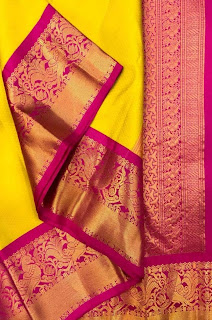TRADITIONAL SAREES FROM MANIPUR : TYPE, DESIGN AND LOOK WITH IMAGES
Manipur, the north-east
state of India is internationally famous for its traditional handloom Industry which has
been flourishing since ages. Manipuri sarees are heritage of traditional tribal craft
work and therefore the legacy
has been carried through generations. One among the unique features of the industry is that ladies are the sole weavers.
Majority of weavers who are skilled in traditional weaving and rendering to intricate designs
to the handlooms belong to Wangkhei, Bamon Kampu, Utlou, Khongman and Kongba
etc. in respect of fine silk items. Rest of the villages of the State producing
all sorts of traditional fabrics.
Five hill districts of the state are specialized in making beautiful designs
and motifs.
Cotton Saree
Cotton Saree is that the most traditional garment of the state of Manipur. Made from 100% cotton, these sarees are made on throw and shuttle looms. In Manipur, the designs of those sarees are of a mix of hill tribal textiles with floral motifs etc. In most cases, designs are woven with traditional temple design in border and floral in cross border.
Silk Saree
Silk Sarees of Manipur are prepared with 100% Eri silk and are woven on fly shuttle and throw looms. Floral, temple and tribal designs adorn these traditional sarees.
• Moirang Phee
Moirang Phee is a traditional textile fabric, formed throughout Manipur which features a specific design called the "Moirang Pheejin" which is woven sequentially on both longitudinal edges of the fabric and oriented towards the middle of the fabric with cotton or silk threads. Manipuri saree with this design is a product, protected under the Geographical Identification Registration and it had been originally a product of Moirang village.
The "Moirang Pheejin" design, known in local language as Yarongphi ('ya' means "tooth", 'rong' means "long"), which is weaved over the traditional Moirang Phee fabric is stated to represent the thin and pointed teeth of the "Pakhangba", the Pythonic god in Manipur mythology. This motif, arranged in varying steps, on the longitudinal border of the fabric woven during the primary stage, features a sharp edge at the highest and is woven sequentially to offer an aesthetic appearance to the saree. The triangular shaped design elongates on odd numbers of steps (such as 3, 5, 9, 11 then forth) towards the middle of the saree on which it's woven, and is parallel to weft threads.


• LEIRUM PHEE
In regard of authentic handloom weave, one among the foremost respectful traditional design is Leirum. It is believe that when any Leirum design cloth is presented to someone it shows the very best sort of regard & respect by the Meitei tribal community.
Leirum Phee is an essential traditional component of Meitei marriage as such cloth has got to be presented by the parents to their daughter. Leirum Phee is a coarse cotton to be carried by the bride to the bridegroom’s place. It is customary to wrap the bridegroom’s pillow and mattress with the Leirum-phee.
However, over the years Leirum design has been used over different clothes also like in sarees.
The Leirum features a traditional design consisting of red, black and white stripes. The white rows are in the middle with small black lines separating each of them and therefore the adjacent sides have black and red rows alternately. The black rows are visually small sized black and white boxes in chess board pattern.












very good blog
ReplyDeleteIndia is all about culture and saree is the super most tredition of India and Thanks to improve my understanding for sarees.
ReplyDeletehttp://shoppingsite.webetwaken.in/
good informative women on saree
ReplyDeleteclose to culture specially cottom saree.
ReplyDeleteVery nice design.
ReplyDeleteVery Nice Post, thank you.Visit Our Website.
ReplyDeleteSatakosia
Chatar Jatra Festival
Maa Jhadi Diye Bhajan